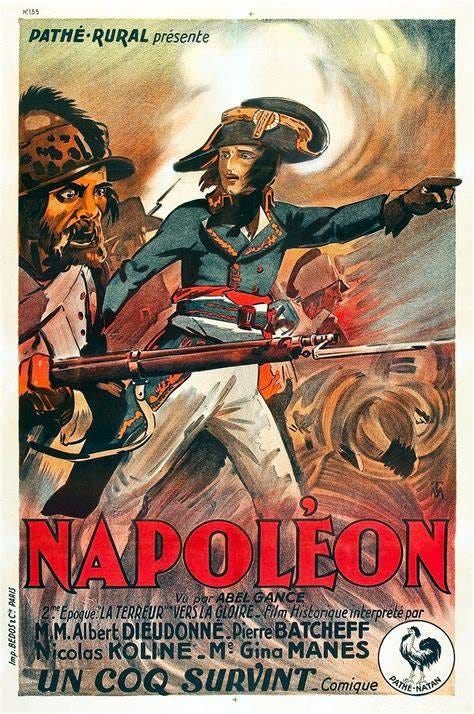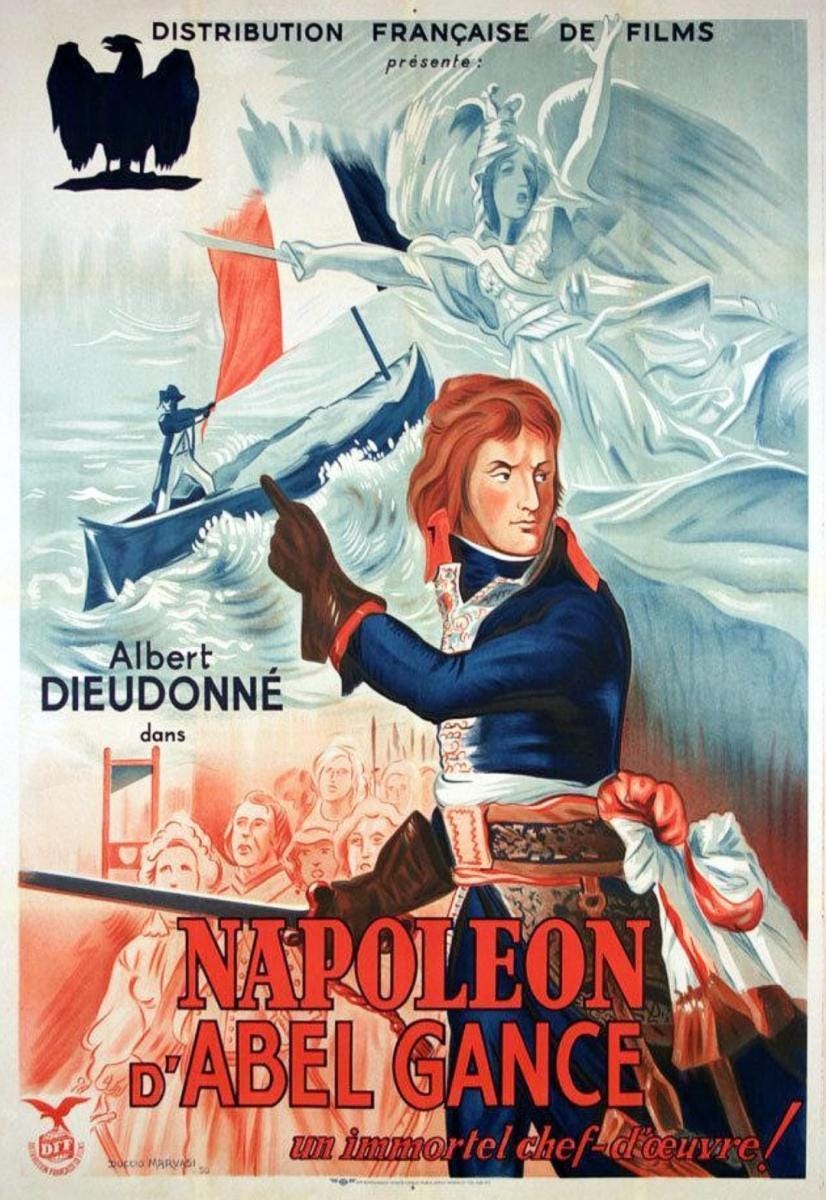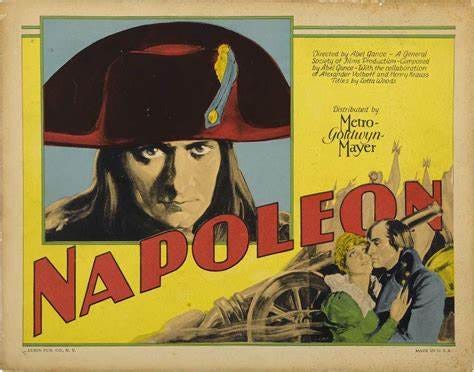Abel Ganze Magnificent NAPOLEON (1927)
It has been called the greatest movie ever made. The greatest silent film ever made. The most innovative film ever made. Does it live up to the rep? It actually surpasses it!
Napoléon is a 1927 French silent epic historical film, produced, and directed by Abel Gance that tells the story of Napoleon's early years. It is also the only film to use Polyvision (for the finale). On screen, the title is Napoléon vu par Abel Gance, meaning "Napoleon as seen by Abel Gance". The film is recognised as a masterwork of fluid camera motion, produced in a time when most camera shots were static. Many innovative techniques were used to make the film, including fast cutting, extensive close-ups, a wide variety of hand-held camera shots, location shooting, point of view shots, multiple-camera setups, multiple exposure, superimposition, underwater camera, kaleidoscopic images, film tinting, split screen and mosaic shots, multi-screen projection, and other visual effects. A revival of Napoléon in the mid-1950s influenced the filmmakers of the French New Wave. The film used the Keller-Dorian cinematography for its color sequences.
Gance planned for Napoléon to be the first of six films about Napoleon's career, a chronology of great triumph and defeat ending in Napoleon's death in exile on the island of Saint Helena. After the difficulties encountered in making the first film, Gance realised that the costs involved would make the full project impossible.
Napoléon was first released in a gala at the Palais Garnier (then the home of the Paris Opera) on 7 April 1927. Napoléon had been screened in only eight European cities when Metro-Goldwyn-Mayer bought the rights to it, but after screening it in London, it was cut drastically in length, and only the central panel of the three-screen Polyvision sequences was retained before it was put on limited release in the United States. There, the film was indifferently received at a time when talkies were just starting to appear.
Napoleon is widely considered to be one of the greatest and most innovative films of the silent era and of all time. Review aggregator Rotten Tomatoes reports that 88% of critics have given the film a positive review, based upon 40 reviews, with an average score of 9.6/10. The website's critics consensus reads: "Monumental in scale and distinguished by innovative technique, Napoléon is an expressive epic that maintains a singular intimacy with its subject."
Napoléon is a 1927 French silent epic historical film, produced, and directed by Abel Gance that tells the story of Napoleon's early years. It is also the only film to use Polyvision (for the finale). On screen, the title is Napoléon vu par Abel Gance, meaning "Napoleon as seen by Abel Gance". The film is recognised as a masterwork of fluid camera motion, produced in a time when most camera shots were static. Many innovative techniques were used to make the film, including fast cutting, extensive close-ups, a wide variety of hand-held camera shots, location shooting, point of view shots, multiple-camera setups, multiple exposure, superimposition, underwater camera, kaleidoscopic images, film tinting, split screen and mosaic shots, multi-screen projection, and other visual effects. A revival of Napoléon in the mid-1950s influenced the filmmakers of the French New Wave. The film used the Keller-Dorian cinematography for its color sequences.
Gance planned for Napoléon to be the first of six films about Napoleon's career, a chronology of great triumph and defeat ending in Napoleon's death in exile on the island of Saint Helena. After the difficulties encountered in making the first film, Gance realised that the costs involved would make the full project impossible.
Napoléon was first released in a gala at the Palais Garnier (then the home of the Paris Opera) on 7 April 1927. Napoléon had been screened in only eight European cities when Metro-Goldwyn-Mayer bought the rights to it, but after screening it in London, it was cut drastically in length, and only the central panel of the three-screen Polyvision sequences was retained before it was put on limited release in the United States. There, the film was indifferently received at a time when talkies were just starting to appear.
Napoleon is widely considered to be one of the greatest and most innovative films of the silent era and of all time. Review aggregator Rotten Tomatoes reports that 88% of critics have given the film a positive review, based upon 40 reviews, with an average score of 9.6/10. The website's critics consensus reads: "Monumental in scale and distinguished by innovative technique, Napoléon is an expressive epic that maintains a singular intimacy with its subject."
Watch NAPOLEAN by clicking here!
Anita Brookner of London Review of Books wrote that the film has an "energy, extravagance, ambition, orgiastic pleasure, high drama and the desire for endless victory: not only Napoleon’s destiny but everyone’s most central hope." The 2012 screening has been acclaimed, with Mick LaSalle of the San Francisco Chronicle calling the film, "A rich feast of images and emotions." He also praised the triptych finale, calling it, "An overwhelming and surprisingly emotional experience." Judith Martin of The Washington Post wrote that the movie "inspires that wonderfully satisfying theatrical experience of whole-heartedly cheering a hero and hissing villains, while also providing the uplift that comes from a real work of art" and praised its visual metaphors, editing, and tableaus.
Peter Bradshaw wrote in The Guardian that Napoleon "looks startlingly futuristic and experimental, as if we are being shown something from the 21st century’s bleeding edge. It’s as if it has evolved beyond spoken dialogue into some colossal mute hallucination." Mark Kermode described the film "as significant to the evolution of cinema as the works of Sergei Eisenstein and D. W. Griffith" that "created a kaleidoscopic motion picture which stretched the boundaries of the screen in every way possible." - Wikipedia
Behind the paywall: CINEMA EUROPE
Highlighting Abel Gance's masterpieces, Napoleon and La Roue. Pretty good documentary on early cinema censorship.
Keep reading with a 7-day free trial
Subscribe to Classics Of The Silent Screen to keep reading this post and get 7 days of free access to the full post archives.






